
Ignimbrites are pumice-dominated pyroclastic flow deposits with subordinate ash.There are many historic examples, most of which are restricted to valleys emanating from summit craters. One such deposit from the 1980 eruption of Mt. St. Helens (below left) contains abundant pumice blocks at its terminus. However, there are no historic examples of the voluminous ignimbrite sheetflows associated with caldera formation. These extensive deposits can cover many thousands of square kilometers. They often appear as coherent, well-compacted, often partially welded, layers that in some cases resemble lava flows, as demonstrated by the Miocene Rio Loa sheetflows of northern Chile (below right).
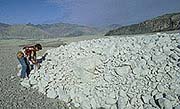 |
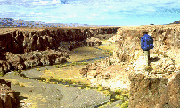 |
|
from Mt. St. Helens |
sheetflows, northern Chile |
The fragmented (pyroclastic) texture of ignimbrites is displayed in the two photos below. Ignimbrites are typically characterized by fist-sized pumice fragments floating in a finer grained matrix (below left). Many ignimbrites, however, are still hot when they are emplaced so that the pumice and ash fragments are still plastic and malleable. Thick, hot ignimbrites will often collapse under their own weight, thus fusing the fragments together to generate a welded flow. In such cases (below right) the pumice fragments are compacted into dark, glassy pancake shapes, called fiamme. A welded ignimbrite containing fiamme is said to have a eutaxitic texture. In some cases, intense welding may be accompanied by internal flow, thus obliterating any of the original flow features. These intensely deformed pyroclastic flows are sometimes refered to as rheomorphic ignimbrites. Not surprisingly, they are often misinterpreted as lava flows.
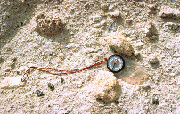 |
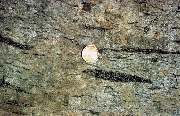 |
|
with pumice fragments |
collapsed pumice (fiamme) |
For a more thorough examination of ignimbritic rock textures on a microscopic level, click on microspopic textures.
A common characteristic of thick ignimbrite sheets is the occurrence of gas-escape structures, or fluidization pipes. In cross section, they appear as vertical columns containing coarse lithic and pumice fragments depleted of fine ash by gas streaming. The veritcal pipes are often oxidized and, in some cases, can be enriched in economically important ore deposits by vapor-phase crystallization. This process cements the interstitial fragments so that the pipes are often resistant to erosion. The vertical spires of the Mazama ignimbrite (below) appear to be fumarole-feeding fluidization pipes cemented into resistant pinnacles by vapor phase crystallization.
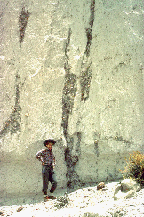 |
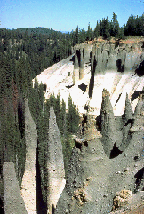 |
|
|
|
Most fluidization pipes appear to form after deposition of the ignimbrite. An historic example of the development of these gas-escape structures is from the 1912 eruption of the Novarupta volcano at Katmai, Alaska. When investigators first travelled to the eruption site they were impressed by the huge number of fumaroles extending over a vast region near the volcano. The region was thus named the Valley of Ten Thousand Smokes. The fumaroles were originally thought to have been from the degassing of an underlying magma chamber. However, it is now known that they were generated by degassing of the ignimbrite sheet produced by the eruption. The Katmai fumaroles are thus "rootless" vents (unconnected to a magma chamber) that developed above fluidization pipes.
Go to: